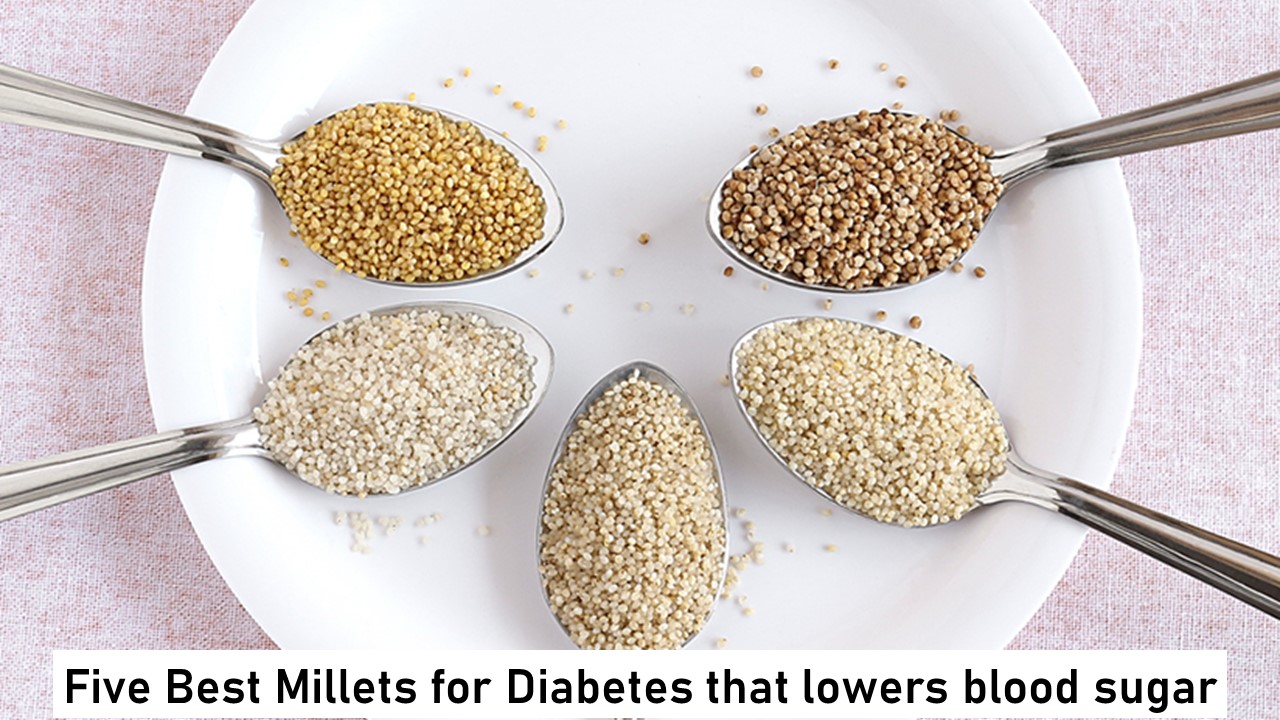5 Best Millets for Diabetes that lowers blood sugar. Diabetes occurs when the body is unable to create or properly use insulin. Hence, the body cannot process meal nutrients into usable energy. If left untreated, this may have severe complications since it can raise your blood sugar level.
One common misconception is that patients with diabetes should avoid sugar and other carbs like millet because these foods might harm their blood sugar levels.
Persons with diabetes must watch their carbohydrate intake more closely to control their blood sugar levels. Still, healthy carbs (especially complex carbs) may also help keep diabetes symptoms under control.
Millet, like other whole-grain carbs, has a lot of beneficial nutrients, including fiber, minerals, and vitamins. Add them to your diet if you have diabetes.
Find out here why millet benefits people with diabetes and how to eat healthily while managing the condition.
The Current Diabetes Situation in India and the Best Millets for Diabetes:
With 77 million diabetic people, India has the second-highest number of people with diabetes globally. The World Diabetes Federation estimates that 463 million people worldwide have diabetes, and diabetes accounts for a surprising 10% of global healthcare spending.
But the pace at which it spreads in India and elsewhere is becoming more alarming. You can easily identify the issue here. It’s all about the food we eat and how we live without exercise. Our diet plays a vital role in diabetes management.
Let’s Understand The Glycemic Index (GI):
The glycemic index (GI) ranks carbohydrates in meals according to how quickly they raise blood sugar levels after digestion. The glycemic index (GI) measures how much a food raises blood sugar by examining how quickly its carbohydrate content turns into glucose.
The effect on blood glucose levels might vary depending on the kind of carbohydrate taken. With the help of the glycemic index, you can fine-tune your carb counting while preparing meals and maintain healthy blood sugar levels.
Blood sugar can be lowered by eating these five types of millet.
Foxtail Millet:
It was shown in research that persons with type 2 diabetes who followed a particular diet high in foxtail millet had reduced levels of blood sugar, cholesterol, and triglycerides. Another study indicated that consuming foxtail millet instead of rice reduced blood sugar levels.
Barnyard Millet:
Barnyard millet can help treat diabetes. New research shows that both diabetic and non-diabetic people saw improvements in their blood sugar and serum cholesterol levels after a 28-day dietary intervention.
Finger Millet :
Anti-diabetic and antioxidant polyphenols were identified in finger millets. Finger millet diets have been shown to lower glycemic response because they are high in fiber and can stop alpha-amylase from functioning properly.
Finger millet steadily increases blood sugar. Consuming foods high in fiber and low in the glycemic index will help you lose weight, control your blood sugar levels, and reduce cholesterol. These elements help diabetic patients.
Pearl Millet :
Studies have shown that pearl millet can improve insulin sensitivity and reduce triglyceride levels. Because of the high fiber content, it is also very beneficial for controlling diabetes. Compared to other meals, it is digested slowly, and glucose is released into the blood more slowly. In diabetics, this is a powerful means of keeping blood sugar stable over the long term.
Little Millet:
Little millet has a lot of tannins and flavonoids, which help prevent diabetes, heart disease, cataracts, cancer, inflammation, GI problems, and aging.
Due to its high fiber content and low glycemic index, little millet is a popular healthy food option for people with diabetes.
Glucose absorption is slowed, keeping blood sugar levels steady. This effect is important for people with diabetes, who must regulate the rise and fall of blood glucose levels.
Benefits of Millet for Diabetes:
- Unlike rice, millets have a low glycemic index (GI), which slowly raises blood sugar levels.
- Because of the high fiber content, digestion is slowed.
- It keeps you satiated for longer, and you won’t experience hunger pangs between meals.
- Millets contain complex carbohydrates, which the body breaks down gradually.
The main goal of diabetes treatment is to keep blood sugar levels healthy and control other risk factors such as blood pressure, cholesterol, and weight. Several strategies may aid in preventing diabetic complications, including:
- Circulatory system disorders
- Injury to the nervous system
- Disorders of the Kidneys
- problem with the eyes
- Skin issues
How can millet be part of everyday meals?
Millet can be used in a variety of dishes.
- Make breakfast porridge with it.
- Millet may be used as a substitute for grains, including rice, wheat, and sooji.
- To increase your millet’s nutritional value and satiety, toss it with grilled veggies or a fresh salad after cooking.
- Make many varieties of millet dosa, and each is served with a unique chutney.
- Switch from maida-based noodles and pasta to millet noodles and whole-grain pasta.
How much to eat?
Millets are high in insoluble fiber, which may help with constipation if eaten in sufficient quantities and with sufficient water.
The recommended daily intake of millet changes based on factors such as an individual’s sensitivity to sugar, digestive health, and calorie needs. Talk to your doctor or dietitian about creating a healthy eating plan.
Conclusion:
Millets help keep blood sugar stable, which is important for diabetes care. It’s possible to utilize millet as a preventative measure, even for those who don’t have diabetes. This way, controlling diabetes effectively requires careful consideration when picking suitable millets. Millets are an excellent addition to a healthy diet.
Formerly known as “the poor man’s grain,” millets have recently been elevated to the status of “nutritious grain” due to their high nutrient content. They can be used in place of regular grains and help people with diabetes keep their blood sugar in check.
FAQs
Can diabetics eat millet every day?
Millet is one of the best whole grains out there for controlling blood sugar levels, and its advantages extend to everyone, regardless of whether they have diabetes. Millet’s high fiber content makes it a healthy option for those with diabetes. The fiber slows down the digestive process.
Which type of millet helps regulate blood sugar the most?
Pearl millet has been shown to improve insulin sensitivity and decrease lipid levels. Because of the high fiber content, it is also very beneficial for controlling diabetes. It is digested slowly, and glucose is released into the blood slower than other meals.
Which millet is ideal for lowering cholesterol?
North-West India, including the states of Rajasthan and Haryana, are big consumers of bajra, also known as pearl millet. Millet, a nutritious grain, is advised for those with diabetes and helps keep cholesterol under control.













